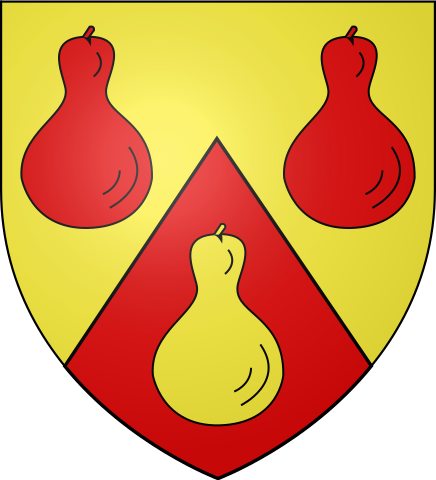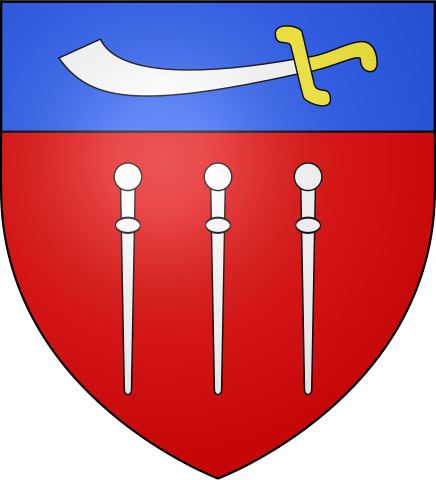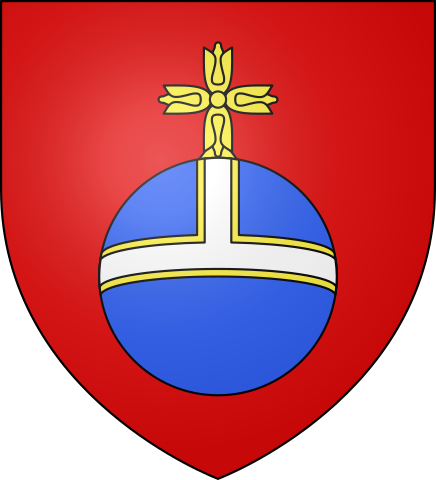According to this page, which quotes heraldic dictionaries from 1816 and 1899, an otelle appears to have been derived from an almond. The Larousse dictionary informs us that otelles usually come in fours, and are arranged either in cross or in saltire. Not a charge which has made much impact on heraldry outside of France, it would seem.Chris Green wrote:Haute-Garonne has a CoA that makes use of the Cross of Languedoc/or Toulouse together with four "otelles" in saltire. What an "otelle" may be I cannot fathom, though they seem to have been borrowed from the arms of the Counts of Comminges, local feudal lords.
Tour de France 2016
- Arthur Radburn
- Posts: 1331
- Joined: 11 Jul 2012, 09:56
Re: Tour de France 2016
Regards
Arthur Radburn
Arthur Radburn
- Chris Green
- Posts: 3627
- Joined: 10 Jul 2012, 13:06
- Location: Karlstad, Sweden
Re: Tour de France 2016
Thank you Arthur. You have an unfathomable resource of obscure heraldic sources!
Not just an almond, but, according to Duhoux, a pike-head (fer de pique), roof-gable (pignon de combles), or tear (larme).
But the most telling suggestion? "... l'espace laissé libre sur le champ de l'écu entre les branches d'une croix pattée." Or in English: "... the space left free on the field of a shield between the arms of a cross patty". Look at the ancient arms of the Counts of Comminges (below) and you immediately see why!
According to this page, which quotes heraldic dictionaries from 1816 and 1899, an otelle appears to have been derived from an almond. The Larousse dictionary informs us that otelles usually come in fours, and are arranged either in cross or in saltire.
Not just an almond, but, according to Duhoux, a pike-head (fer de pique), roof-gable (pignon de combles), or tear (larme).
But the most telling suggestion? "... l'espace laissé libre sur le champ de l'écu entre les branches d'une croix pattée." Or in English: "... the space left free on the field of a shield between the arms of a cross patty". Look at the ancient arms of the Counts of Comminges (below) and you immediately see why!
Chris Green
IAAH President
Bertilak de Hautdesert
IAAH President
Bertilak de Hautdesert
- Chris Green
- Posts: 3627
- Joined: 10 Jul 2012, 13:06
- Location: Karlstad, Sweden
Re: Tour de France 2016
Thursday's stage takes the Tour from Montpellier to the dreaded Mont Ventoux, scene of the death of the English rider Tom Simpson on 13 July 1967. On the way the riders pass through Vergèze whose arms are:

The French blazon uses "cantonée" to indicate that the four roses should appear in the four corners of the shield. But this only works when the shield is to all intents and purposes a quadrilateral as here.
A little while later the race passes through Tarascon whose arms feature a fearsome local beast devouring one of the inhabitants. Indeed the town itself bears the name of the beast.
https://en.wikipedia.org/wiki/Tarasque

Still later comes Gordes whose arms are canting:

Note the French way of blazoning what the Anglo-Saxons describe as "per chevron".

Blazon: English: Azure a Greyhound courant collared Gules between four Roses Argent. Francais: D'azur au lévrier courant d'argent, colleté de gueules, cantonné de quatre roses aussi d'argent.
The French blazon uses "cantonée" to indicate that the four roses should appear in the four corners of the shield. But this only works when the shield is to all intents and purposes a quadrilateral as here.
A little while later the race passes through Tarascon whose arms feature a fearsome local beast devouring one of the inhabitants. Indeed the town itself bears the name of the beast.
https://en.wikipedia.org/wiki/Tarasque

Blazon: English: Per fess Gules and Azure, in chief resting on the partition a Castle with three towers Argent windowed and masoned Sable its entrance ungated, in base a six-legged Tarasque Or devouring a Man Argent. Francais: Coupé : au premier de gueules au château donjonné de trois tourelles d'argent, ouvert du champ, ajouré et maçonné de sable, posé sur la partition , au second d'azur à la tarasque de six pattes d'or avalant un homme d'argent
Still later comes Gordes whose arms are canting:

Note the French way of blazoning what the Anglo-Saxons describe as "per chevron".
Blazon: English: Per chevron Or and Gules three Gourds two and one counterchanged. Francais: De gueules à la gourde d'or, au mantel du même chargé de deux gourdes aussi de gueules.
Chris Green
IAAH President
Bertilak de Hautdesert
IAAH President
Bertilak de Hautdesert
- Chris Green
- Posts: 3627
- Joined: 10 Jul 2012, 13:06
- Location: Karlstad, Sweden
Re: Tour de France 2016
Friday's time trial starts at Bourg-Saint-Andéol which features three "bourdons", the usual English for which is "bumble-bee". Clearly these are not bees. There are archaic meanings, one of which is "church bell" and the other is "lance" and the latter must surely be the intention. However the artist seems to have no idea what a lance should look like. He/she is on firmer ground with "badelaire" which translates as "scimitar".

The finish is at Vallon-Pont-d'Arc whose arms are simple, but potentially confusing:

Of course these days most chess-rooks look like heraldic towers, so the artist needs to consider carefully what was intended before putting pencil to paper.

Blazon: Francais: De gueules aux trois bourdons d'argent posés en pal et rangés en fasce, au chef cousu d'azur chargé d'un badelaire d'argent garni d'or.
The finish is at Vallon-Pont-d'Arc whose arms are simple, but potentially confusing:

Blazon: English: Gules three Chess-Rooks Or. Francais: De gueules à trois rocs d'échiquier d'or.
Of course these days most chess-rooks look like heraldic towers, so the artist needs to consider carefully what was intended before putting pencil to paper.
Chris Green
IAAH President
Bertilak de Hautdesert
IAAH President
Bertilak de Hautdesert
- Arthur Radburn
- Posts: 1331
- Joined: 11 Jul 2012, 09:56
Re: Tour de France 2016
My guess is that the charge is a pilgrim's staff. That is also a meaning of 'bourdon', and such staves feature in the canting arms of several English and South African families named Burden.Chris Green wrote:Friday's time trial starts at Bourg-Saint-Andéol which features three "bourdons", the usual English for which is "bumble-bee". Clearly these are not bees. There are archaic meanings, one of which is "church bell" and the other is "lance" and the latter must surely be the intention. However the artist seems to have no idea what a lance should look like. He/she is on firmer ground with "badelaire" which translates as "scimitar".
Regards
Arthur Radburn
Arthur Radburn
- Chris Green
- Posts: 3627
- Joined: 10 Jul 2012, 13:06
- Location: Karlstad, Sweden
Re: Tour de France 2016
My guess is that the charge is a pilgrim's staff. That is also a meaning of 'bourdon', and such staves feature in the canting arms of several English and South African families named Burden.
Indeed! I have now found a further explanation that suggests "baton de pélérin" which translates as pilgrim's staff.
"Avoir le bourdon" means, not to have the bee, the lance or even the pilgrim's staff, but to have the blues.
Chris Green
IAAH President
Bertilak de Hautdesert
IAAH President
Bertilak de Hautdesert
- Chris Green
- Posts: 3627
- Joined: 10 Jul 2012, 13:06
- Location: Karlstad, Sweden
Re: Tour de France 2016
Saturday's stage starts at Montélimar in the Département of Drome (with a circumflex over the o).
Montélimar's arms are not, as one might guess "Gules semy of pieces of nougat proper", but:

It is strange that while the charge clearly depicts what is called in English an "orb" its heraldic description is "mound" which is a distortion of the French "monde" which means "world" which in Latin is "orbis terrarum".
The cyclists' destination is Villars-les-Dombes in the Département of Ain. The arms of Villars are simple and traditional:

I thought that these might have been the arms of the illustrious Maréchal-Général Claude Louis Hector Duc de Villars, who fought Marlborough and Eugène on many a field, not least Malplaquet (11 September 1709). But it seems that his arms were quite dissimilar:

Montélimar's arms are not, as one might guess "Gules semy of pieces of nougat proper", but:

Blazon: Gules a Mound Azure banded Argent fimbriated Or and surmounted with a Cross Or. Français : de gueules au monde d'azur cintré d'argent bordé d'or et croisé du même.
It is strange that while the charge clearly depicts what is called in English an "orb" its heraldic description is "mound" which is a distortion of the French "monde" which means "world" which in Latin is "orbis terrarum".
The cyclists' destination is Villars-les-Dombes in the Département of Ain. The arms of Villars are simple and traditional:

Blazon: English: Bendy of six Or and Gules. Francais: Bandé d'or et de gueules de six pièces.
I thought that these might have been the arms of the illustrious Maréchal-Général Claude Louis Hector Duc de Villars, who fought Marlborough and Eugène on many a field, not least Malplaquet (11 September 1709). But it seems that his arms were quite dissimilar:

Chris Green
IAAH President
Bertilak de Hautdesert
IAAH President
Bertilak de Hautdesert
- Chris Green
- Posts: 3627
- Joined: 10 Jul 2012, 13:06
- Location: Karlstad, Sweden
Re: Tour de France 2016
Saturday's stage starts from Bourg-en-Bresse whose simple arms are:

Later the cyclists pass through Hauteville-Lompnès. The blazon is another example of how the Gallic approach is completely at odds with the Anglo-Saxon. To the French the field is Argent and the Azure corners are called "vetements" (circumflex over the first e) (in English "vestments" or "clothes"). To Anglo-Saxons the field is obviously Azure and the lion is on a lozenge "throughout" (touching the edges of the shield). I must say I am not enamoured of four tiny suns - as small as ermine tails. The sun, like the lion rampant, should never be a minor charge.

The finishing line is at Culoz whose arms bear witness to the proximity of the River Rhone and the mountain "Grand Colombier" ("colombier" usually translates as "pigeon-loft" or "dovecote", but the mountain is long and squat, not the least bit like a dovecote).

Today's homework is an English version of this blazon.

Blazon: English: Per pale Vert and Sable a Cross bottony Argent. Français : Parti de sinople et de sable à la croix tréflée d'argent brochant sur la partition.
Later the cyclists pass through Hauteville-Lompnès. The blazon is another example of how the Gallic approach is completely at odds with the Anglo-Saxon. To the French the field is Argent and the Azure corners are called "vetements" (circumflex over the first e) (in English "vestments" or "clothes"). To Anglo-Saxons the field is obviously Azure and the lion is on a lozenge "throughout" (touching the edges of the shield). I must say I am not enamoured of four tiny suns - as small as ermine tails. The sun, like the lion rampant, should never be a minor charge.

Blazon: English: Azure between four Suns, on a Lozenge throughout Argent a Lion Rampant Gules between four Ermine Tails. Français : D'argent au lion de gueules accompagné de quatre mouchetures d'hermine de sable ordonnées 1, 2 et 1, au vêtement d'azur chargé de quatre soleils aussi d'argent.
The finishing line is at Culoz whose arms bear witness to the proximity of the River Rhone and the mountain "Grand Colombier" ("colombier" usually translates as "pigeon-loft" or "dovecote", but the mountain is long and squat, not the least bit like a dovecote).

Blazon: Français : coupé : au premier parti à dextre d'or au sapin de sinople posé sur un mont de sable mouvant de la pointe et à senestre aussi d'or à la tour de gueules, maçonnée et ajourée de sable, brochant sur un chevron du même, au second d'argent aux deux fasces ondées d'azur soutenues chacune d'un croissant de gueules.
Today's homework is an English version of this blazon.
Chris Green
IAAH President
Bertilak de Hautdesert
IAAH President
Bertilak de Hautdesert
- Arthur Radburn
- Posts: 1331
- Joined: 11 Jul 2012, 09:56
Re: Tour de France 2016
Chris Green wrote:Later the cyclists pass through Hauteville-Lompnès. The blazon is another example of how the Gallic approach is completely at odds with the Anglo-Saxon. To the French the field is Argent and the Azure corners are called "vetements" (circumflex over the first e) (in English "vestments" or "clothes"). To Anglo-Saxons the field is obviously Azure and the lion is on a lozenge "throughout" (touching the edges of the shield). I must say I am not enamoured of four tiny suns - as small as ermine tails. The sun, like the lion rampant, should never be a minor charge.
The "vêtements" are evidently a combination of chapé and chaussé, which mean a headdress and footwear respectively, so "vestments" is an appropriate collective term for them.
Baron de Stalins' Vocabulaire-Atlas gives the term as "vêtu en losange". The Spanish, Italian and Dutch translations also refer to being "clothed", whereas the English is given as "vêtu (on a losange)", and the German translation refers to a lozenge throughout.
This design looks far better on an 'accolade' shield such as this rendition and this one. More room for the suns in base.
Regards
Arthur Radburn
Arthur Radburn
- Chris Green
- Posts: 3627
- Joined: 10 Jul 2012, 13:06
- Location: Karlstad, Sweden
Re: Tour de France 2016
Monday's stage starts from Moirans-en-Montagne whose arms are canting:

Further south in the Languedoc there is considerable evidence of the Moorish incursion into southern Europe. Here is a quote from
http://www.midi-france.info/1011_moors.htm
Whether the name of the Commune, and hence the canting arms, come from the presence historically of Moors in the Jura mountains, is a matter of conjecture. I have a sneaking feeling that a false connection was made at some point on the distant past and that "Moirans" may in fact stem from "moraine" (an accumulated mass of glacial debris).
Travelling north-east the Tour crosses into Switzerland at Les Verrières, whose arms are:

But to get there they will have passed through the French commune of Verrières-de-Joux, whose arms are:

Confusing?
The finishing line is at Bern/Berne, whose well-known arms are:

The blazon in English is usually given as: Gules on a bend Or a Bear passant Sable armed langued and pizzled of the field. One may cavil as to whether as illustrated the bend can properly be described as a bend, or should perhaps be called a "Bernese bend" in the same way as the broad pale in the Canadian flag has been designated a "Canadian pale". But given that the Bernese have used their arms since 1289 I think we might allow them their use of the bend without any special description.

Blazon: English: Or a Moor's Head erased at the neck facing dexter in dexter chief a molet Sable. Francais: D'or à une tête de maure accompagnée en chef-dextre d'une étoile de sable
Further south in the Languedoc there is considerable evidence of the Moorish incursion into southern Europe. Here is a quote from
http://www.midi-france.info/1011_moors.htm
In the Languedoc you will find a few reminders of the presence of the Moors, for example names such as Castelmaur (Castle of the Moors) and Castelsarrasin (Castle of the Saracens), the medical school at Montpellier, and odd remnants like a doorway at Narbonne.
Whether the name of the Commune, and hence the canting arms, come from the presence historically of Moors in the Jura mountains, is a matter of conjecture. I have a sneaking feeling that a false connection was made at some point on the distant past and that "Moirans" may in fact stem from "moraine" (an accumulated mass of glacial debris).
Travelling north-east the Tour crosses into Switzerland at Les Verrières, whose arms are:

But to get there they will have passed through the French commune of Verrières-de-Joux, whose arms are:

Confusing?
The finishing line is at Bern/Berne, whose well-known arms are:

The blazon in English is usually given as: Gules on a bend Or a Bear passant Sable armed langued and pizzled of the field. One may cavil as to whether as illustrated the bend can properly be described as a bend, or should perhaps be called a "Bernese bend" in the same way as the broad pale in the Canadian flag has been designated a "Canadian pale". But given that the Bernese have used their arms since 1289 I think we might allow them their use of the bend without any special description.
Chris Green
IAAH President
Bertilak de Hautdesert
IAAH President
Bertilak de Hautdesert
Who is online
Users browsing this forum: No registered users and 20 guests